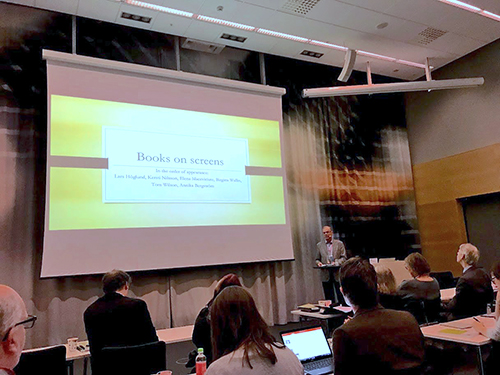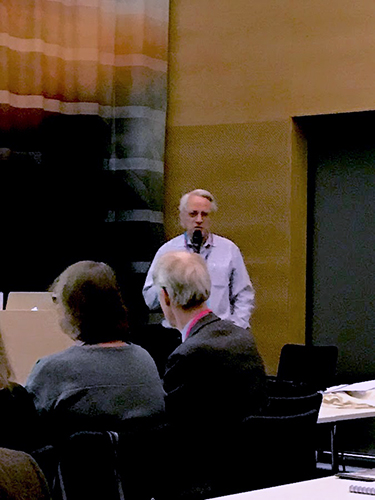Our project is now formally ended, with the publication of the monograph by Nordicom, and the holding of a final research seminar in Borås on the 24th November. We had invited other e-book researchers from the Nordic countries and around Europe, as well as colleagues from the University of Borås, and the audience totalled about thirty persons, including researchers from Croatia, Lithuania, the Netherlands and Norway.
The event began with a welcome by Professor Ann-Sofie Axelsson, Dean of the Faculty of Library and Information Science, Pedagogics and IT, and presentation of the monograph and a description of the publishing activities of Nordicom, by Professor Ingela Wadbring. This was followed by presentations on the project overall, by Lars Höglund, the authors, by Kersti Nilsson, the publishers, by Elena Maceviciute, booksellers and public libraries, by Birgitta Wallin, academic libraries, by Tom Wilson, and the readers, by Annika Bergström. There was a break for lunch during that first session and then presentations by Terje Colbjörnsen, Frank Huysmans, Zoran Velagić, Arunas Gudinavičius, and a final word, summing up his reactions to the seminar, by Adriaan van der Weel.

You can see the project presentation here, while, below, are synopses of the other presentations, with links to the PowerPoint slides.
Streaming books: Value proposition and competitive advantages in three Norwegian ebook and audio book streaming services.
Terje Colbjørnsen, University of Oslo.
While streaming remains a marginal phenomenon in the global trade book industry at large, a number of streaming services have emerged in later years and competition is fierce to attain favourable market positions. The paper compares three Norwegian ebook and audio book streaming services: Storytel (Norwegian version), Fabel and Ebok.no Pluss. The three services all offer an on-demand selection of digital books at a flat rate, but are distinctly different in other aspects of their offering such as size of catalogue and integration with other services. Storytel, as the service with the largest catalogue, is most clearly aiming to be a “Spotify for digital books”, but still lacks rights for titles from dominant Norwegian publishing houses Gyldendal and Aschehoug. Fabel is a service coming out of precisely these two houses and offers a smaller, more niche-oriented and focused service, with audio books only. Ebok.no Pluss, owned by publisher Vigmostad & Bjørke, comes across as a mixed offer, integrating its service with an ebook store while also aiming to be a broad, Spotify-like provider. In all the three services, we find that the business model and value proposition is closely related to the company’s corporate ownership and its institutional and historical positioning in the book industry. While the Norwegian Book Agreement aims at enabling a level playing field, the digital field of competition remains marked by consumer lock-in and lack of broad, universal offerings of the Spotify-kind.
Link to the presentation

E-book lending through public libraries in the Netherlands: trends and experiences
Frank Huysmans, University of Amsterdam.
Under the new public library act of 2015, the Royal Library (Koninklijke Bibliotheek) of the Netherlands, in close collaboration with the public library sector, operates two e-lending platforms for Dutch citizens based on a ‘one copy multiple users’-model. First there is the national e-lending platform currently offering 16,000 titles. All 3.7 million members of the ca 154 public library organizations can make an account (the Netherlands have paid memberships for adults, whereas most children and youth up to 16 years can have a membership without cost). So far, over 400,000 of them have registered, of which slightly over 200,000 borrow at least one e-book per year. Second, the Holiday Library app can be downloaded by all citizens (both public library members and non-members). During the summer holidays, this e-library is ‘open’ and a limited number of titles (30 for adults and 30 for kids and youth) can be downloaded in-app and read for free). In the summer of 2017, around 800,000 accounts and over 2 million e-book downloads were registered.
These developments are discussed in the context of commercial e-book subscription services and e-book sales. So far, there is no evidence for ‘cannibalization’ of e-book sales when the same e-book titles are available for e-lending through the library portal, although in general a window of 6 months applies. Also, the steady increase in the e-lending numbers can not completely compensate for the drop in the lending numbers of paper books in Dutch public libraries.
Link to the presentation

Overview of the Croatian e-book market
Zoran Velagić, Department of Information Sciences, University of Osijek, Croatia
Franjo Pehar, Department of Information Sciences, University of Zadar, Croatia
Zoran Velagić presented this jointly prepared outline of the e-book development in Croatia based on surveys of mayor e-book distributors and publishers’ attitudes towards e-books (using the instruments designed by the Swedish project). Four surveys of e-book distributors were conducted between February 2013 and February 2017, while two self-completed questionnaire surveys of publishers’ attitudes towards e-books were conducted in Spring 2015 and Spring 2017. The findings show that the number of unique e-book titles in Croatian language throughout the period is small (below 2000), while the access to English language production is rising. Around 50 publishers participate in the e-book business, and a majority have plans to increase their share of the market. The most popular e-book format is EPUB, the average retail price is EUR 5-6, but almost half of Croatian language e-books are freely-accessible thanks to government sponsored projects. Publishers are still not sure about the changing relations towards booksellers, libraries, and readers.
Link to the presentation
How much cheaper are e-books? The analysis of e-book prices in small language e-book markets
Arūnas Gudinavičius, Vilnius University, Faculty of Communication, Digital Media Lab.
It is believed that e-books should be much cheaper than printed books. And mostly they are cheaper, in spite of the fact that, in most European countries, the price of an e-book usually includes full VAT, rather than a reduced rate. But how much exactly are e-books cheaper, how much can a reader save if he buys e-books? And what is the difference between the prices in small language e-book markets such as Croatian, Finnish, Estonian, Latvian, Lithuanian, Norwegian, Slovenian, Swedish? How does this difference correlate with the reduced VAT for printed books, or with the number of e-book titles on sale?
A small research project was carried out to answer these questions aboved. The largest (with the most titles for sale) e-book retailer in each country was selected. Two shopping lists (one for e-books, another for printed books of the same titles) were created from the retailer of each country. If the particular largest e-book retailer had no printed books on sale, the largest print book retailer was selected. E-book best seller lists were used to create the shopping lists. If there were no best seller lists, lists of the new books were used. Books prices in national currencies were converted into Euro according to exchange rate of the research day. The percentage difference (with VAT included and VAT excluded) in e-books and printed books prices were calculated and compared between countries. Preliminary results showed that differences between e-book and book prices exist and vary between the countries. Different VAT regulations also affect final prices.
Link to the presentation
[Pictures by Helen Rosenberg and Tom Wilson]




You must be logged in to post a comment.